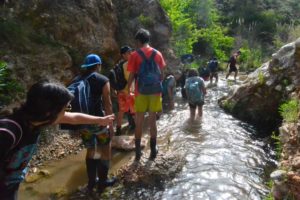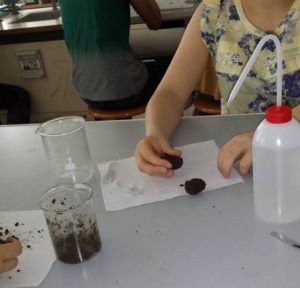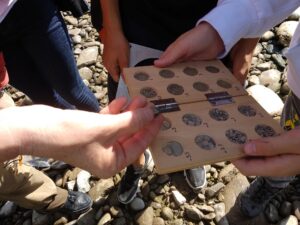DAYLIGHTING RIVERS
Due to urbanization, many of the rivers that once flowed naturally through European cities have been covered over, or culverted – creating “hidden” waterways that are part of the urban drainage system, but now flow underground beneath paved streets or other urban structures. The environmental consequences of such culverting, which include flooding hazards, loss of biodiversity and ecological vitality, and intensified urban heating, are becoming increasingly apparent as the frequency of extreme weather events continues to rise in a globally changing climate. In addition, the absence of natural streambeds deprives the city’s residents of the valuable social and economic benefits associated with riverside parkland, such as opportunities for recreation and tourism amenities.
In response, there has been a growing interest in the restoration of natural water flows in urban areas by re-exposing such hidden rivers to the environment – through a process of deculverting, or “daylighting.” The daylighting of urban rivers can create new habitat for plants and animals, potentially reduce flood risks, and create new ‘green corridors’ through urban areas with benefits for recreational and other services.

STEM
Daylighting Rivers aimed to develop multidisciplinary resources for teachers and students in disciplines of Science, Technology, Engineering and Mathematics.
Since the Rocard report in 2007 many efforts have been made by EC for increasing the number students in science and technology studies, but there are still evidences of the unevenness in basic science literacy but also a scarce interest and motivation in science studies and careers.
In addition, there are still evidences of a gap between research findings and what happens in the classroom; a scarce understanding of the extent of competence required of teachers or educators for achieving accomplishments and further competences; an insufficient family involvement to inspire children’ curiosity.
These issues must be undertaken by fostering the best methodologies in science education, making students more involved, raising up their curiosity, competences, investigation and problem solving skills.
Direct and multidisciplinary experiences on local territory such as exploring own town and local rivers can trigger the scientific understanding of the landscape and its threats. We believe that doing science with outdoors experiences will give students the stimulus for a deeper undrstanding of the land trasformation processes and real challenges, enhancing questioning capacity and the curiosity to investigate in an appropriate way.
Moreover, among the recommendations for a better citizenship, there is also the shifting of learning from STEM to STEAM because all disciplines, even Art contribute to the understanding and knowledge of scientific principles.
The model of IBL that DAYLIGHTING RIVERS applies is a model summarized by Pedaste et al. (2015). For more information, download the methodology guidelines of Daylighting Rivers.

Inquiry based Learning
Learning is enhanced when students are asked to build their own solutions, and when they acquire practical experience by doing. IBL engages students in active and self-directed learning, resembling the type of investigation pursued by scientists.
Active exploration usually leads to a better conceptual understanding, and through IBL, students construct knowledge by asking questions, formulating hypotheses, designing and executing their own investigations and evaluating and reflecting on their findings. In addition, IBL helps students see relevant uses of the knowledge to make sense of what they are learning; interweave laboratory experiences with other types of science learning activities, including lectures, reading, and discussion; engage students in group work and increase their communication skills; engage students in ICT for the public engagement
Diagnostic, formative assessments are embedded into the instructional sequence and can be used to gauge the students’ developing understanding and to promote their self-reflection on their thinking.
DAYLIGHTING RIVERS offers educational materials for a learning process that addresses the understanding of complex systems related to rivers (e.g. water cycle, river ecosystem, soil-water interactions, land use effects and impacts, rivers in the arts, etc.) through scientific investigations, including hands-on activities or using Geographic Information Systems.

The model of IBL that DAYLIGHTING RIVERS applies is a model summarized by Pedaste et al. (2015). For more information, download the methodology guidelines of Daylighting Rivers.
SKILLS
Students often perceive a gap between what is learned at school and what is relevant in the workplace. Therefore the acquisition of skills and competencies is crucial, since it can also impact their choice of educational pathways or facilitate their entrance into the labour market.
Transversally, the project activities will concern school subjects like geography, biology, chemistry, botany, soil and water science, and economics – but also will engage students in the integrative skills of urban planning and land use studies, with the use of technologies and software. The activities are designed to raise environmental awareness on the importance of preserving soil and rivers under pressure from urbanisation.
In terms of soft skills, students are encouraged to work in groups, to take responsibility for specific tasks within a defined time frame, and to communicate their findings to peers and the general public by adapting their language and means of communication to fit the target audience.
Responsible Citizenship
The challenges our society have to face are many and include social, economical and especially environmental threats. Regarding the project themes, due to accelerated urban development, many rivers have been diverted or culverted, in favor of urban infrastructures and new neighborhoods. This has increased the risks of flood, led to the loss of biodiversity along the streams, increased water pollution and impaired other for the community services connected to the flowing water. The process by which the culverted or covered rivers are uncovered and re-exposed to the environment is known as ‘daylighting’. DAYLIGHTING RIVERS also refers to ‘daylighting’ in terms of youth consciousness – raising awareness and inspiring global action for sustainability in water use.
Responsible research and Innovation
Responsible Research and Innovation (RRI) means that societal actors work together during a research and innovation process in order to better align both the process and its outcomes, with the values, needs and expectations of European society. It anticipates and assesses potential implications and societal expectations with regard to research and innovation, with the aim to foster the design of inclusive and sustainable research and innovation.
Among others, RRI fosters the Public Engagement – which is about co-creating the future between citizens and civil society organizations on matters of science and technology and bringing on board the widest possible diversity of actors that do not normally interact with each other and Gender Equality to ensure a more integrated approach and Ethics as ethical compliance is seen as pivotal to achieve real research excellence.
Building capacities and developing innovative ways of connecting science to society is a priority, therefore, starting from the schools, there is a need to make science more attractive to young people, increase society’s appetite for innovation, and open up further research and innovation activities.
